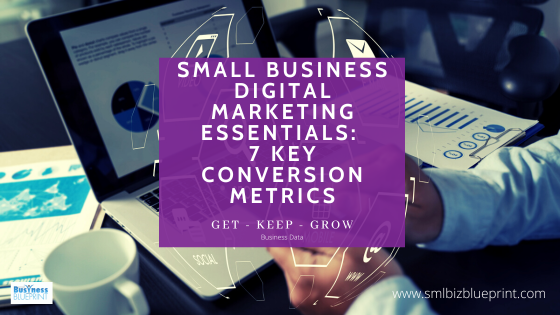Understanding and leveraging the proper conversion metrics is pivotal for business growth in the digital age.
For small to medium-sized business owners embarking on digital marketing, knowing which metrics to focus on can make the difference between a thriving online presence and a stagnant one.
This guide will delve into the top 7 conversion metrics, providing actionable insights for those just starting in digital marketing.
Sign up for more insightful content delivered straight to your inbox! Join Our Newsletter

#1 Website Traffic: The Gateway to Customer Engagement
Website traffic is more than a number; it reflects your business’s digital footprint.
Analysing traffic trends reveals the effectiveness of your marketing efforts and the appeal of your brand.
Dive deeper into the source of traffic – organic, referral, direct, or social – to understand which channels are most effective.
Employ advanced analytics to segment your audience, tailor your content, and adjust your marketing tactics in real-time to resonate with your target demographic.
Actions
Leverage SEO:
Optimise your website for search engines to increase organic traffic. Use relevant keywords quality content, and ensure your site is mobile-friendly.
Utilise Social Media:
Share engaging content on social media platforms to drive traffic to your website. Tailor your content to each platform and engage with your audience.
Run Targeted Ads:
Use paid advertising on platforms like Google Ads or social media to target specific demographics and drive traffic to your site.
#2 Lead Conversion Rate: From Visitor to Prospect
The transition from visitor to lead is a testament to your website’s capability to engage and persuade. It’s not just about the quantity of leads but the quality.
Optimise your website for conversions by creating a seamless user experience, incorporating persuasive calls-to-action, and utilising lead magnets like eBooks, webinars, or free trials.
Regularly analyse and refine your landing pages and lead generation forms to ensure they are as effective as possible in capturing high-quality leads.
Actions
Optimise Landing Pages:
Ensure your landing pages are clear, compelling, and relevant to your audience. Use A/B testing to find the most effective design and content.
Use Strong Calls-to-Action:
Make clear what action you want visitors to take with visible and persuasive CTAs.
Offer Value:
Provide value like ebooks, webinars, or free trials to entice visitors to provide their contact information.
#3 Cost Per Conversion: Maximizing Marketing Efficiency
Cost per conversion is the linchpin of financial prudence in digital marketing. A low cost per conversion indicates a high return on investment, which is crucial for businesses with tight budgets.
To optimise this, invest in targeted and retargeted ads, refine your SEO strategies for organic reach, and consistently analyse which channels yield the best results. It’s about smart spending, not just spending less.
Actions
Track and Analyze Data:
Regularly monitor your advertising campaigns and use analytics to understand which performs best.
Refine Target Audience:
Narrow your target audience to ensure your marketing efforts reach the most likely to convert.
Test and Adjust:
Continuously test different aspects of your marketing campaigns, like ad copy or targeting criteria, and adjust based on performance data.

#4 Customer Lifetime Value (CLV): Predicting Long-Term Growth
CLV is the crystal ball of your business’s future, forecasting the potential revenue a single customer can generate.
Enhancing CLV involves creating an exceptional customer experience, building loyalty through personalised communication, and implementing effective upselling and cross-selling strategies.
This metric guides allocating marketing resources where they most effectively nurture long-term customer relationships.
Actions
Focus on Customer Service:
Provide excellent customer service to increase customer satisfaction and retention.
Implement Loyalty Programs:
Create loyalty programs that reward repeat customers and encourage them to continue doing business with you.
Personalised Communication:
Use customer data to personalise your marketing efforts, making customers feel valued and understood.
#5 Bounce Rate: Keeping Your Audience Engaged
A high bounce rate often signals a misalignment between your visitors’ expectations and what your website delivers.
To captivate and retain your audience, create compelling content that aligns with their interests and intent.
Ensure your site’s design is intuitive and loading times are swift. Use engaging visuals and interactive elements to enhance user experience. Regularly updating content and improving the overall user interface are key steps in reducing bounce rate.
Actions
Improve Website Speed:
Ensure your website loads quickly to prevent visitors from leaving out of frustration.
Enhance User Experience:
Make your website easy to navigate with a clear structure and intuitive design.
Create Engaging Content:
Regularly update your website with fresh, relevant content that answers your visitors’ questions and keeps them engaged.
#6 Social Media Engagement: Beyond Likes and Shares
Social media engagement is the heartbeat of your brand’s online presence. It’s not just about counting likes and shares; it’s about fostering a community.
Engage your audience with storytelling, interactive content, and timely responses to comments and messages. Utilise analytics to understand what content resonates with your audience and when they are most active.
Authentic, consistent engagement on social media builds your brand and drives traffic back to your site.
Actions
Post Regularly:
Keep a consistent posting schedule to stay in front of your audience.
Engage with Your Audience:
Actively respond to comments and messages to foster a community and build relationships.
Use Visuals and Videos:
Add images, infographics, and videos to your posts to increase engagement and shares.

#7 Email Open and Click-Through Rates: Email Marketing Mastery
In email marketing, high open and click-through rates are indicators of compelling content and audience relevance.
Personalise your emails based on user behaviour and preferences. Craft subject lines that intrigue and promise value.
Segment your email list to deliver tailored content and offers.
Continuously test different elements of your emails, from the subject line to the call-to-action, to optimise for maximum engagement.
Actions
Segment Your Email List:
Tailor your emails to different audience segments based on their interests and behaviours.
Craft Compelling Subject Lines:
Create subject lines that grab attention and encourage recipients to open your emails.
Include Clear CTAs:
Make it obvious what you want the reader to do next, with a clear and compelling call to action in each email.
Essential Actions
Optimise Website for Conversion and User Experience:
Your website is often the first point of interaction with potential customers. A well-optimized site can significantly increase the likelihood of converting visitors into leads and customers.
Action Steps:
- Ensure your website has a clear, compelling value proposition.
- Simplify navigation and streamline the user interface for ease of use.
- Implement clear, persuasive calls-to-action (CTAs) to guide visitors towards conversion points like contact forms, product pages, or downloads.
Leverage Data-Driven Email Marketing:
Email marketing remains one of the most effective digital marketing channels for return on investment. Personalised, targeted emails can drive engagement, conversions, and sales.
Action Steps:
- Segment your email list based on customer behaviour and preferences.
- Create personalised email campaigns that speak directly to the needs and interests of each segment.
- Use strong, engaging subject lines and clear email CTAs to boost open rates and click-throughs.
Utilise Social Media to Engage and Convert:
Social media platforms offer a direct line to engage with your target audience. Properly managed, they can drive traffic, build brand loyalty, and directly influence sales.
Action Steps:
- Identify and focus on the social media platforms where your target audience is most active.
- Post engaging, relevant content regularly and interact authentically with your audience through comments, messages, and posts.
- Run targeted social media ad campaigns to promote products or services, using compelling visuals and tailored messaging.
Strategic Innovations
Incorporating Chatbots for Enhanced Customer Interaction:
Chatbots can revolutionise customer service and engagement on your website. They provide instant responses to customer queries, significantly improving user experience and leading to better conversion rates.
Action Steps:
- Implement a chatbot on your website that can answer frequently asked questions, guide users through your site, and even help with shopping.
- Customise the chatbot responses to reflect your brand’s tone and personality, making the interaction more engaging and personalised.
Leverage User-Generated Content:
User-generated content (UGC), such as customer reviews, photos, or testimonials, can provide social proof and build trust with prospective customers. It’s a powerful tool to enhance authenticity and can influence buying decisions.
Action Steps:
- Encourage your customers to share their experiences with your products or services on social media.
- Feature this UGC on your website and social media channels, ensuring credit for the original posters. This can also improve engagement and foster a community around your brand.
Integrating Interactive Content:
Interactive content like quizzes, polls, and infographics can significantly increase user engagement and time spent on your site. This type of content is engaging and can provide valuable insights into your audience’s preferences and behaviours.
Action Steps:
- Create interactive quizzes related to your industry that can help users understand their needs or preferences while simultaneously collecting data for your marketing efforts.
- Use polls on social media to engage your audience and gather opinions or feedback that can inform future content or product development.
Conclusion
These seven conversion metrics are the pillars of a successful digital marketing strategy.
They offer a deep understanding of your audience, the effectiveness of your marketing efforts, and areas for improvement. By mastering these metrics, you equip your business with the tools to navigate and thrive in the digital marketplace.
Remember, knowledge is power in digital marketing, but applied knowledge is supremacy. Use these insights to refine your strategy, connect with your audience, and achieve unparalleled growth.
FAQs
Q1: How can I increase my website traffic?
A1: Optimise your website for search engines (SEO) to improve your organic search rankings.
Create high-quality, relevant content that addresses your audience’s needs and interests.
Utilise social media platforms to promote your content and direct traffic to your website.
Consider using paid advertising, like Google Ads or social media ads, to reach a larger audience.
Engage in guest blogging or collaborations with other websites to expand your reach.
Q2: What are effective strategies to improve my lead conversion rate?
A2: Optimise your website’s landing pages to ensure they are compelling and clearly communicate value.
Use A/B testing to experiment with different elements of your website and find what works best.
Offer lead magnets, such as free ebooks, webinars, or trials, that require visitors to provide their contact information.
Ensure your calls-to-action (CTAs) are clear, persuasive, and strategically placed throughout your website.
Personalize user experience as much as possible to cater to individual visitor preferences.
Q3: How do I calculate and optimise my cost per conversion?
A3: Calculate your cost per conversion by dividing the total cost of your marketing campaign by the number of conversions it generated.
To optimise this metric, refine your target audience to ensure your marketing efforts reach the most relevant people.
Experiment with different marketing channels and strategies to find the most cost-effective approach.
Regularly review and adjust your campaigns based on performance analytics.
Q4: What is Customer Lifetime Value, and how can I maximise it?
A4: Customer Lifetime Value (CLV) is the total revenue you can expect from a single customer throughout their relationship with your business.
Increase CLV by enhancing customer satisfaction through excellent service and high-quality products.
Implement loyalty programs and personalised marketing strategies to encourage repeat business.
Focus on customer retention strategies, as retaining existing customers is often more cost-effective than acquiring new ones.
Q5: What causes a high bounce rate, and how can I reduce it?
A5: A high bounce rate can be caused by various factors, including slow page load times, poor user experience, irrelevant content, or technical issues.
To reduce bounce rate, ensure your website is fast, mobile-friendly, and easy to navigate.
Create engaging, relevant content that matches the intent of your visitors.
Use clear, compelling CTAs to guide visitors to other relevant pages on your site.
Q6: How can I increase engagement on my social media platforms?
A6: Post regularly and consistently to maintain a steady presence on your chosen platforms.
Create and share content that resonates with your audience, such as videos, images, polls, and interactive posts.
Engage directly with your audience by responding to comments, messages, and mentions.
Run contests, giveaways, or interactive campaigns to encourage participation and sharing.
Q7 What are some tips for improving email open and click-through rates?
A7: Use compelling and personalised subject lines to grab attention.
Segment your email list to send targeted, relevant content to different groups within your audience.
Keep your emails concise, visually appealing, and easy to read.
Include clear, compelling CTAs that encourage recipients to take a specific action.
Test and optimise your emails’ send times, frequency, and content for the best engagement.

